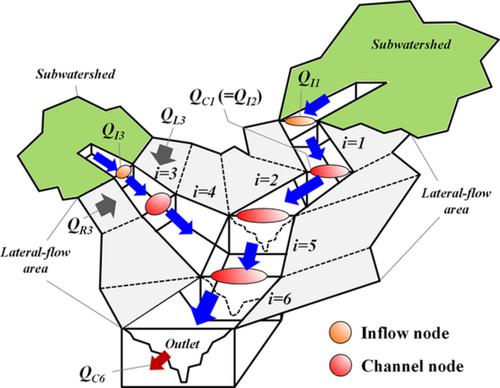当前位置:
X-MOL 学术
›
Hydrol. Process.
›
论文详情
Our official English website, www.x-mol.net, welcomes your
feedback! (Note: you will need to create a separate account there.)
Refinement of the channel response system by considering time‐varying parameters for flood prediction
Hydrological Processes ( IF 2.8 ) Pub Date : 2020-08-04 , DOI: 10.1002/hyp.13868 Pin‐Chun Huang, Kwan Tun Lee
Hydrological Processes ( IF 2.8 ) Pub Date : 2020-08-04 , DOI: 10.1002/hyp.13868 Pin‐Chun Huang, Kwan Tun Lee

|
Impulse response functions derived from different types of flood wave equations (simplified shallow water equations) are continuously developed to conduct the linear channel routing (LCR), which is based on the linearized Saint Venant equation and has been widely applied to avoid any possibility of numerical instability. The impulse response function proposed by Dooge, Napiórkowski, and Strupczewski (1987) and derived from the dynamic wave equation with complete force terms has been acknowledged as a classic work to establish a good physical interpretation for the LCR model; however, the flexibility of altering the shape of impulse response still needs to be improved. Based on the concept of this work, this study intends to introduce the time‐varying parameters in the model, so the values of parameters can be adjusted according to the inflow condition, flood stage, and the cross‐sectional shape. Moreover, an integrated routing procedure is proposed to formulate the impulse response function for lateral‐flow inputs and then to connect multiple inputs from subwatersheds or alongside the main channel with the impulse response function of each channel segment to reflect the spatial variation of hydraulic characteristics among different segments. In the discussion of this article, the impulse response function is analysed to show its sensitivity to hydraulic variables with spatial and temporary variations. Flood‐event simulations of a studied watershed are also provided to verify the applicability of the proposed channel routing system.
中文翻译:

考虑时变参数进行洪水预报的渠道响应系统优化
不断开发从不同类型的洪水波方程式(简化的浅水方程式)导出的脉冲响应函数,以进行基于线性化的圣维南方程式的线性通道路由(LCR),并已广泛应用于避免任何数值计算的可能性不稳定。由Dooge,Napiórkowski和Strupczewski(1987)提出并从具有完整力项的动态波动方程派生的脉冲响应函数已被认为是为LCR模型建立良好物理解释的经典著作。然而,改变脉冲响应形状的灵活性仍然需要提高。基于这项工作的概念,本研究旨在在模型中引入时变参数,因此,可以根据流入条件,溢流阶段和横截面形状来调整参数值。此外,提出了一种综合路由程序,为侧向流输入量制定冲激响应函数,然后将子流域或主河道的多个输入与每个通道段的冲激响应函数相连接,以反映水力特征之间的空间变化。不同的细分市场。在本文的讨论中,分析了脉冲响应函数以显示其对具有空间和临时变化的水力变量的敏感性。还提供了一个研究分水岭的洪水事件模拟,以验证所提出的渠道路由系统的适用性。提出了一种综合的路径规划方法,以公式化侧流输入的冲激响应函数,然后将子流域或主通道旁边的多个输入与每个通道段的冲激响应函数连接起来,以反映不同段之间水力特性的空间变化。在本文的讨论中,分析了脉冲响应函数以显示其对具有空间和临时变化的水力变量的敏感性。还提供了一个研究分水岭的洪水事件模拟,以验证所提出的渠道路由系统的适用性。提出了一种综合的路径规划方法,以公式化侧流输入的冲激响应函数,然后将子流域或主通道旁边的多个输入与每个通道段的冲激响应函数连接起来,以反映不同段之间水力特性的空间变化。在本文的讨论中,分析了脉冲响应函数以显示其对具有空间和临时变化的水力变量的敏感性。还提供了一个研究分水岭的洪水事件模拟,以验证所提出的渠道路由系统的适用性。
更新日期:2020-08-04
中文翻译:

考虑时变参数进行洪水预报的渠道响应系统优化
不断开发从不同类型的洪水波方程式(简化的浅水方程式)导出的脉冲响应函数,以进行基于线性化的圣维南方程式的线性通道路由(LCR),并已广泛应用于避免任何数值计算的可能性不稳定。由Dooge,Napiórkowski和Strupczewski(1987)提出并从具有完整力项的动态波动方程派生的脉冲响应函数已被认为是为LCR模型建立良好物理解释的经典著作。然而,改变脉冲响应形状的灵活性仍然需要提高。基于这项工作的概念,本研究旨在在模型中引入时变参数,因此,可以根据流入条件,溢流阶段和横截面形状来调整参数值。此外,提出了一种综合路由程序,为侧向流输入量制定冲激响应函数,然后将子流域或主河道的多个输入与每个通道段的冲激响应函数相连接,以反映水力特征之间的空间变化。不同的细分市场。在本文的讨论中,分析了脉冲响应函数以显示其对具有空间和临时变化的水力变量的敏感性。还提供了一个研究分水岭的洪水事件模拟,以验证所提出的渠道路由系统的适用性。提出了一种综合的路径规划方法,以公式化侧流输入的冲激响应函数,然后将子流域或主通道旁边的多个输入与每个通道段的冲激响应函数连接起来,以反映不同段之间水力特性的空间变化。在本文的讨论中,分析了脉冲响应函数以显示其对具有空间和临时变化的水力变量的敏感性。还提供了一个研究分水岭的洪水事件模拟,以验证所提出的渠道路由系统的适用性。提出了一种综合的路径规划方法,以公式化侧流输入的冲激响应函数,然后将子流域或主通道旁边的多个输入与每个通道段的冲激响应函数连接起来,以反映不同段之间水力特性的空间变化。在本文的讨论中,分析了脉冲响应函数以显示其对具有空间和临时变化的水力变量的敏感性。还提供了一个研究分水岭的洪水事件模拟,以验证所提出的渠道路由系统的适用性。











































 京公网安备 11010802027423号
京公网安备 11010802027423号